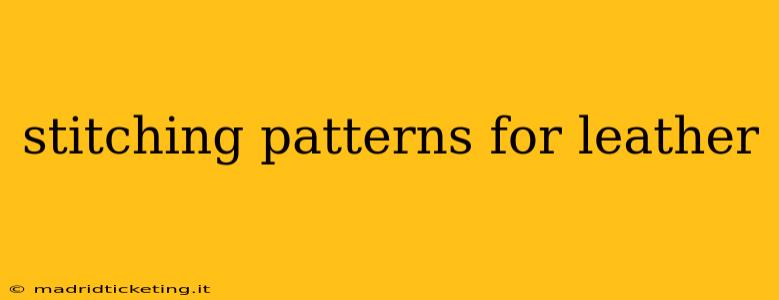Leather stitching elevates a project from functional to exquisite. Whether you're crafting a wallet, a belt, a bag, or even intricate leather armor, the right stitching pattern not only adds strength and durability but also contributes significantly to the overall aesthetic appeal. This guide explores various leather stitching patterns, their applications, and the tools you'll need to master this rewarding craft.
What are the Different Types of Leather Stitching?
Several stitching patterns cater to different needs and aesthetic preferences. The choice often depends on the project's intended use, the thickness of the leather, and your personal style.
1. Saddle Stitch: This is arguably the most popular and durable method. It involves passing the needle through both layers of leather, creating a strong, even stitch that resists pulling and tearing. The characteristic "X" pattern on the reverse side adds visual appeal and extra strength. Saddle stitching is ideal for items that need to withstand considerable stress, such as belts, bags, and wallets.
2. Baseball Stitch: A variation of the saddle stitch, the baseball stitch uses a slightly different needle entry and exit point, resulting in a more decorative, less uniform look on the reverse side. This pattern remains incredibly strong and is a popular choice for projects where a slightly more rustic aesthetic is desired.
3. Blind Stitch: Designed to be virtually invisible from the outside, this stitch is perfect for concealing stitching in refined leather goods. It requires precise needle placement and practice to master, but the results are stunningly clean. Common uses include finishing edges or creating seamless joins.
What Tools Do I Need for Leather Stitching?
Having the right tools makes a world of difference in achieving clean, consistent stitches. Essential tools include:
- Stitching Groover: This tool creates a consistent groove to guide your stitching, preventing the thread from sinking too deeply or sitting too shallowly. This results in a much neater, more professional finish.
- Stitching Needles: Specifically designed for leatherwork, these needles typically have a triangular or diamond-shaped point to easily pierce the leather. Choose needles appropriate for the leather thickness.
- Leather Thread: Use strong, waxed thread designed specifically for leather. Waxed thread adds durability and helps it glide smoothly through the leather.
- Pricking Irons (optional): These tools help create evenly spaced holes for your stitches, especially useful for beginners. However, practice allows for accurate hand-piercing as well.
- Awl (optional): An awl can be used to create holes for stitching, especially in thicker leather.
How Strong is Leather Stitching?
The strength of your leather stitching depends heavily on the chosen pattern, thread quality, and your stitching technique. A properly executed saddle stitch or baseball stitch is exceptionally strong, surpassing the strength of many adhesives. The double-needle technique inherently creates greater durability than single-needle stitches.
Which Stitch is Best for Beginners?
The saddle stitch is an excellent starting point for beginners. While it requires patience and practice, the relatively simple technique and forgiving nature of the stitch make it ideal for learning fundamental stitching skills.
What Kind of Thread Should I Use for Leather Stitching?
Always use a high-quality, waxed thread designed specifically for leatherwork. These threads are stronger and more resistant to abrasion than regular sewing thread. The wax helps the thread glide smoothly through the leather, preventing snagging and breakage.
How Do I Prevent My Leather Stitching from Ripping?
Preventing rips hinges on choosing the right stitch (saddle stitch is your best bet), using durable, waxed thread, and mastering proper stitching techniques. Make sure your stitches are consistently spaced and tensioned to prevent uneven stress on the seams.
This comprehensive guide provides a strong foundation for exploring the world of leather stitching. Remember that practice is key – the more you stitch, the more confident and proficient you'll become. Happy stitching!

